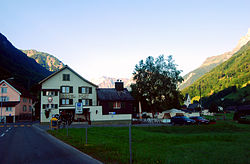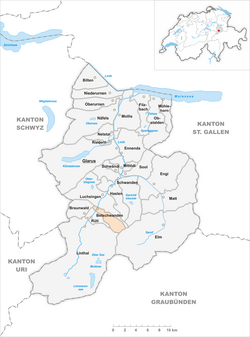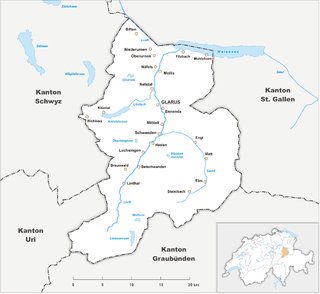
The canton of Glarus is a canton in east central Switzerland. The capital is Glarus. The population speaks a variety of Alemannic German. The majority of the population (81%) identifies as Christian, about evenly split between Protestants and Catholics.

Glarus is the capital of the canton of Glarus in Switzerland. Since 1 January 2011, the municipality Glarus incorporates the former municipalities of Ennenda, Netstal and Riedern.

Braunwald is a car-free resort village in the municipality of Glarus Süd and canton of Glarus in Switzerland.

Spiringen is a village and a municipality in the canton of Uri in Switzerland. The municipality comprises two disjoint areas, separated by the municipality of Unterschächen and the Klausen Pass. The western area includes the village of Spiringen in the Schächen Valley, whilst the eastern area includes the Urner Boden alp above Linthal and the canton of Glarus.
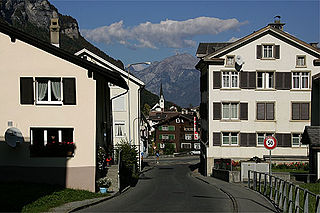
Linthal is a village and former municipality in the municipality of Glarus Süd and canton of Glarus in Switzerland. The village lies near the head of the valley of the Linth river, and at the foot of the Klausen Pass into the canton of Uri. It is the terminus of the railway line that traverses the length of Glarus.

Elm is a village, and former municipality, in the municipality of Glarus Süd and canton of Glarus in Switzerland. Elm lies in the valley of the Sernf river, and consists of the village of Elm itself, and the hamlets of Sulzbach, Schwändi, Müsli, Untertal, Vogelsang, Töniberg, Obmoos, Steinibach and Wald.

Haslen is a village, and former municipality, in the municipality of Glarus Süd and canton of Glarus in Switzerland.

Luchsingen is a village and former municipality in the municipality of Glarus Süd and canton of Glarus in Switzerland.

Mitlödi is a village and former municipality, in the municipality of Glarus Süd and canton of Glarus in Switzerland.

Mollis is a former municipality in the canton of Glarus in Switzerland. Effective from 1 January 2011, Mollis is part of the municipality of Glarus Nord.

Netstal is a former municipality in the canton of Glarus in Switzerland. Effective from 1 January 2011, Netstal is part of the municipality of Glarus.

Schwanden is a village, and former municipality, in the municipality of Glarus Süd and canton of Glarus in Switzerland.

Rüti is a village, and former municipality, in the municipality of Glarus Süd and canton of Glarus in Switzerland.

Leuggelbach is a village, and former municipality, in the municipality of Glarus Süd and canton of Glarus in Switzerland.

Nidfurn is a village, and former municipality, in the municipality of Glarus Süd and canton of Glarus in Switzerland.

Diesbach is a village, and former municipality, in the municipality of Glarus Süd and canton of Glarus in Switzerland.
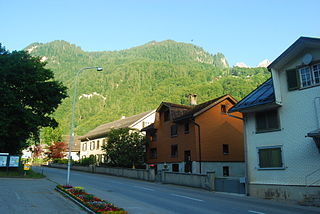
Hätzingen is a village, and former municipality, in the municipality of Glarus Süd and canton of Glarus in Switzerland.
Glarus Süd is a municipality in the Swiss canton of Glarus. It comprises the upper Linth valley, and the entire Sernf valley, and includes the villages of Betschwanden, Braunwald, Diesbach, Elm, Engi, Haslen, Hätzingen, Leuggelbach, Linthal, Luchsingen, Matt, Mitlödi, Nidfurn, Rüti, Schwanden, Schwändi and Sool.

Linthal Braunwaldbahn railway station is a railway station in the municipality of Glarus Süd in the Swiss canton of Glarus. It is situated on the Weesen to Linthal railway line in the valley of the Linth river, some 500 metres (1,600 ft) short of the terminus of the line at Linthal station in the village of Linthal. The station opened in 1982 in order to provide a convenient interchange with the Braunwaldbahn funicular to the car-free resort of Braunwald on the mountain above.

The S25 is a regional railway line of the S-Bahn Zürich on the Zürcher Verkehrsverbund (ZVV), Zürich transportation network, and is one of the network's lines connecting the cantons of Zürich with Schwyz, Glarus and St. Gallen. The line was introduced in July 2014, and replaces the less frequent Glarner Sprinter train.
